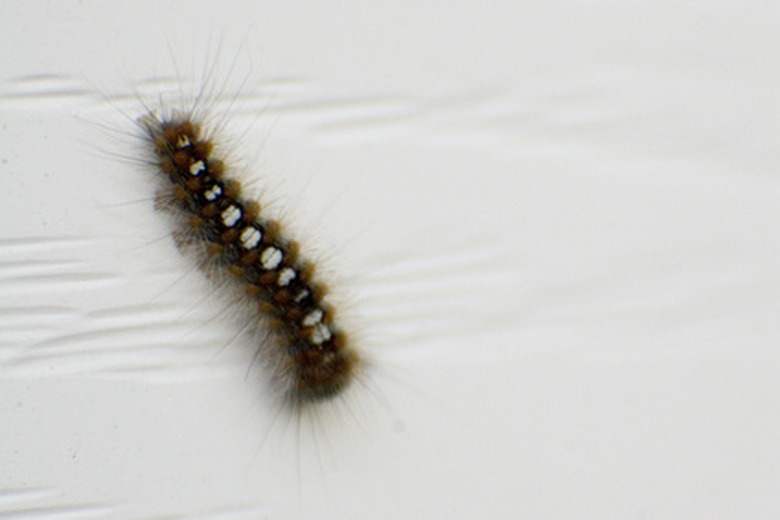Insects That Kill Oak Trees
The term \"mighty oak\" trumpets the strength and grandeur of a species of one of North America's hardiest trees. Able to survive forest fires and protected in many areas against human encroachment, oak trees are no matches for their biggest enemy–a wide range of tiny insects. From defoliation to degradation caused by their voracious appetite, these tiny predators have no respect for the term or the tree.
Forest Tent Caterpillar
The forest tent caterpillar enjoys dining on oaks and other hardwoods in the eastern states. While these caterpillars will not always kill the host tree, there is substantial growth loss and die-back. The resulting defoliation can lead to tree death if it occurs over a three-year span. The caterpillars have pale-blue lines and a brown body with a row of keyhole-shaped spots down a black back. Adult moths are brown with dark bands. The first signs of an attack are sparse treetop crowns. Caterpillars will often work in clusters on the lower trunks. Eggs hatch in early spring and feed on opening buds and flowers. Contrary to its name the caterpillar does not form tents. ?Moths emerge from late May to July and deposit their eggs in winter. Several chemicals and a microbial insecticide are used for control as well as natural means such as cold and predators.
- The term \"mighty oak\" trumpets the strength and grandeur of a species of one of North America's hardiest trees.
- While these caterpillars will not always kill the host tree, there is substantial growth loss and die-back.
Oak-stem borer
The Oak-stem borer usually begins its attacks in the small branches at the top of an oak tree or on small side twigs. Hungry for seedlings, the oak-stem borer larvae will tunnel in twigs and then down into the main trunk to the root collar. The larvae will consume the insides of a stem and at times leave it completely hollow. The result is brown foliage, dying branches and ultimately dead seedlings. The Oak-stem borers can become abundant and kill a large number of young oaks. Insecticides can be applied and infected branches and dead trees should be removed and destroyed.
Two Lined Chestnut Borer
Red and white oaks are the most susceptible to the Two Lined Chestnut Borer. The larvae are white, slender and flattened with two spines at the rear and are the true culprits as they excavate winding trails in the inner bark and outer wood of the trunk and branches of the oak. The attacks begin in the treetops and wind their way downward. Trees weekend by defoliation and drought seem to be most susceptible. Prevention of defoliation is the best way to avoid an attack and trunk spray can be effective in killing off the larvae.
- The Oak-stem borer usually begins its attacks in the small branches at the top of an oak tree or on small side twigs.
- Prevention of defoliation is the best way to avoid an attack and trunk spray can be effective in killing off the larvae.
Gypsy moth
The gypsy moth is one of the most dangerous pests to red and white oaks in the Northeast. The larvae (a caterpillar) cause widespread defoliation resulting in loss of vigor, reduced growth and mortality. Brown with tufts of hair on each segment, the larvae have six pairs of red spots. Younger larvae chew holes in the leaves while the older larvae feed on the edges. It is possible to see an entire tree defoliated in a short amount of time. The attacks begin in May after the hatching of eggs laid before the winter. Gypsy moths are controlled by introduced insect parasites, predators and chemical and microbial insecticides.
- The gypsy moth is one of the most dangerous pests to red and white oaks in the Northeast.
- The larvae (a caterpillar) cause widespread defoliation resulting in loss of vigor, reduced growth and mortality.
Oak Skeletonizer
The oak skeletonizer seeks out red oaks and while most trees can resist a single attack, repeated attacks weaken a tree, causing it to thin and even die-back. The larvae are yellow and green and can be seen spinning silk threads. Adults in moth form have black wings marked with paler areas. The caterpillars converge on the green park of a leaf–in particular the lower surface–giving the leaves a digitized brownish look. The result is premature leaf drop and defoliation. Burning or disposal of dropped leaves is recommended to destroy cocoons, and insecticides may be needed for large-scale problems.
